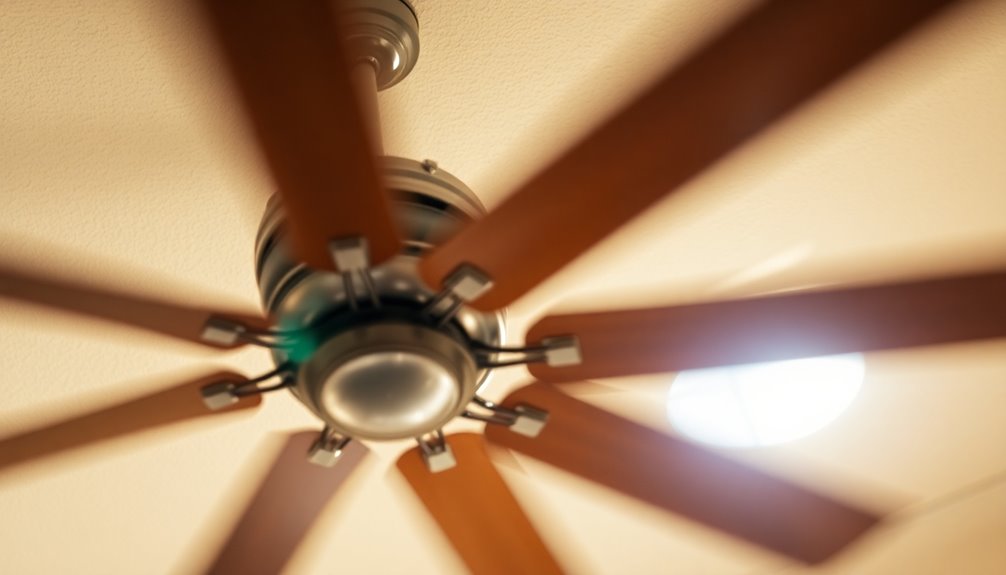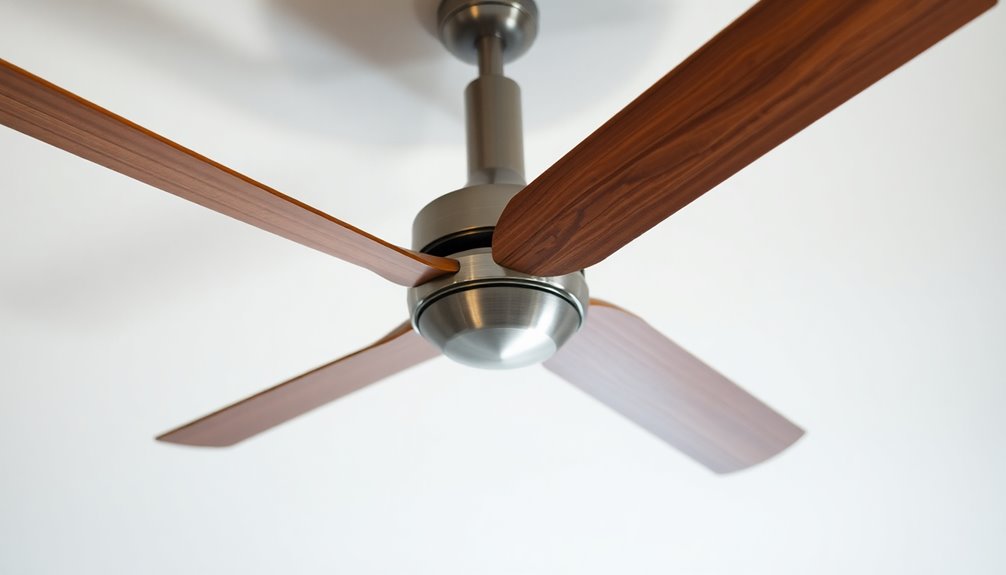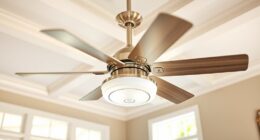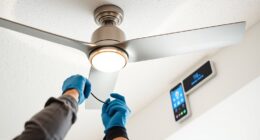If your ceiling fan's shaking, it could be due to a few common issues. Loose screws in the blades or mounting bracket often cause wobbling, as do warped blades from humidity. Dust buildup on one side of the blades can create uneven weight, increasing the shake. Improper installation may also lead to instability. Start by inspecting and tightening any loose hardware. Regular maintenance, like cleaning and checks, can help prevent these problems. Want to know more about fixing and maintaining your fan? There are several useful tips to keep it running smoothly and safely.
Key Takeaways
- Loose screws on blades or the mounting bracket can cause significant shaking in your ceiling fan.
- Warped blades due to humidity or environmental factors disrupt the fan's balance, leading to wobbling.
- Dust accumulation on one side of blades creates uneven weight distribution, increasing instability while in motion.
- Improper installation or incorrect spacing between blades and ceiling may result in excessive movement during operation.
- Normal wear and tear can loosen hardware over time, contributing to the fan's shaking.
Common Causes of Wobbling

A ceiling fan shaking can be frustrating, and it often stems from a few common causes. One major culprit is loose screws. If the screws securing the blades or the mounting bracket aren't tight, the fan can wobble considerably during operation.
Similarly, warped blades can disrupt the balance, often caused by environmental factors like humidity or temperature changes.
Another factor to take into account is the accumulation of dust and dirt on one side of the fan blades. This buildup can create uneven weight distribution, leading to increased wobbling.
Additionally, improper installation can play a role. If the spacing between the blades and the ceiling isn't correct, it can cause excessive movement, especially at higher speeds.
Lastly, don't forget that normal wear and tear can contribute to a fan's instability. Over time, loose hardware may develop, causing the fan to shake during use.
To keep your ceiling fan functioning smoothly, regular maintenance is key. By checking for loose screws, cleaning the blades, and ensuring proper installation, you can minimize wobbling and enjoy a more stable airflow. Proper alignment can also enhance fan performance by ensuring quiet and efficient operation.
Tools Needed for Fixing

To tackle the shaking of your ceiling fan, you'll need a few handy tools. Having the right equipment can make the process smoother and more efficient, so let's get started!
- Ladder or Step Stool: You'll need a sturdy ladder or step stool for safe access to your ceiling fan. This guarantees you can reach the blades comfortably while working.
- Screwdriver: A screwdriver is essential for tightening any loose screws that might be causing the wobble. Check all screws on the fan and the mounting bracket to verify everything's secure.
- Ceiling Fan Balancing Kit: This kit typically includes clips and adhesive weights, which are vital for identifying and correcting blade imbalances. You'll use it to make precise adjustments to get your fan back in balance.
Don't forget a clean cloth to wipe away any dust that could affect the fan's performance.
Finally, masking tape can help you mark specific blades during your balancing process, making it easier to keep track of your adjustments.
With these tools in hand, you'll be well-equipped to tackle that shaking ceiling fan!
Step-by-Step Repair Guide

To fix your shaking ceiling fan, you'll first want to identify the causes of the wobbling.
Start by inspecting and tightening all hardware to guarantee everything is secure.
If the problem persists, consider using a balancing kit to achieve a smoother operation.
Identify Wobbling Causes
Ceiling fan wobbling can be frustrating, but identifying the causes is the first step toward a solution. Here's what you should look for:
- Loose Screws: Check if any screws on the fan blades or motor are loose. This can disrupt the balance and lead to a wobbling ceiling fan.
- Uneven Weight Distribution: Dust accumulation on one side of the fan blades can create uneven weight distribution. Regularly clean your blades to maintain balance.
- Misalignment: If your fan blades are misaligned due to improper installation or environmental changes, this can cause excessive shaking.
To tackle these issues, consider using a blade balancing kit; it helps adjust the weight on the blades effectively.
Regular maintenance is essential—make it a habit to inspect your fan blades and hardware.
Inspect and Tighten Hardware
Sometimes, a simple inspection and tightening of hardware can resolve the shaking of your ceiling fan. Start by checking all the screws that secure the fan blades to the blade holders. Loose screws can lead to wobbling and shaking, so make certain they're tight.
Next, inspect the mounting bracket that attaches the fan to the ceiling. Use a screwdriver to tighten any loose screws you find; this will help prevent the fan from shaking during operation.
Don't forget to check the downrod and hanging hardware as well. Verify these components are securely fastened to eliminate any potential movement that could cause shaking.
After you've tightened all the necessary screws, run the fan at different speeds to test for stability. If you still notice wobbling, revisit your inspection and make any additional adjustments.
To maintain your fan's stability, it's a good idea to schedule regular inspections and tighten the hardware as needed. This simple practice can extend the lifespan of your ceiling fan and enhance its performance, keeping your space comfortable and quiet.
Use Balancing Kit
After tightening the hardware, a balancing kit can help eliminate any remaining wobbling in your ceiling fan.
This kit usually includes plastic clips and adhesive weights, which are essential for adjusting the weight distribution of the blades.
Follow these steps for proper installation:
- Attach the plastic clip to the end of one blade. Run the fan to see which blade causes the most wobble.
- Adjust the position of the clip along the blade until you find the spot that minimizes the wobble. This may take a few tries, so be patient!
- Secure adhesive weights to the blade where the clip was placed. Remove the clip and test the fan at high speed to guarantee stability.
Balancing Your Ceiling Fan

To achieve a smoothly operating ceiling fan, balancing it's vital. If your ceiling fan is wobbling, it could be due to uneven blade spacing, loose screws, or dust accumulation.
Start by checking that all blades are securely attached and evenly spaced. You can measure the distance from each blade to the ceiling to verify they're at the same height. If the fan continues to wobble after these checks, consider using a ceiling fan balancing kit. This kit usually includes clips and adhesive weights that help you identify and correct imbalances.
Regular cleaning is also important. Dust buildup on one side of the fan can affect its balance, so make it a habit to wipe down the blades.
Additionally, inspect the screws on the blades and the mounting hardware, tightening any that are loose. Confirming that all blades are perfectly level will prevent further wobbling issues.
Maintenance Tips for Longevity

Maintaining your ceiling fan is vital for guaranteeing its longevity and ideal performance. Regular upkeep can prevent wobbling and mechanical issues, allowing you to enjoy a cool breeze without worry. Here are some significant maintenance tips:
- Clean ceiling fan blades regularly. Dust accumulation can lead to imbalances and shaking, so wipe them down with a damp cloth to keep them in top shape.
- Inspect and tighten screws and connections periodically. This simple step guarantees that all parts remain secure and stable, preventing any unexpected movements.
- Lubricate the fan motor and moving parts according to the manufacturer's instructions. Proper lubrication keeps everything running smoothly and extends the life of your fan.
Additionally, consider using a ceiling fan balancing kit to maintain blade equilibrium if you notice any wobbling. Regular maintenance checks are essential for optimal performance, similar to how home security systems require periodic evaluations to ensure effectiveness.
Scheduling professional maintenance every few years can also help address underlying issues that mightn't be visible to you.
Signs You Need Professional Help

If your ceiling fan shakes persistently despite your balancing efforts, it's time to call in a pro.
Unusual noises or vibrations can also indicate that something's wrong and needs expert attention.
Don't ignore these signs, as they can lead to safety hazards if left unchecked.
Persistent Wobbling Issues
Ceiling fans can sometimes wobble, and when that happens, it's crucial to pay attention. A wobbly ceiling fan isn't just annoying; it can signal deeper issues that need professional help.
Here are some signs you shouldn't ignore:
- Wobbling exceeds 1/8-inch: This can pose safety risks and indicates a need for professional evaluation.
- Persistent wobbling after attempts to balance a ceiling fan: If your DIY fixes aren't working, it could mean structural problems exist.
- Blades show signs of warping: Damaged blades might require replacement blades or even a complete unit replacement.
If your fan operates noisily or has a noticeable decline in speed, these could be signs of mechanical issues that require expert attention.
Remember, fans older than ten years often face difficulties that are tough to diagnose without the right expertise. Trying to fix these problems yourself can lead to further complications.
Unusual Noises or Vibrations
Unusual noises or vibrations from your ceiling fan can be more than just a nuisance; they often signal underlying issues that need immediate attention.
If you hear grinding or rattling sounds, it's likely due to loose components or misalignment that require professional assessment. Persistent vibrations exceeding 1/8-inch wobbling indicate serious imbalance issues, which can pose safety risks if not addressed promptly.
Buzzing noises may point to electrical problems or motor malfunctions, both of which should be evaluated by a qualified technician. Additionally, if your fan shakes considerably at high speeds, it might be suffering from worn-out bearings or warped blades, necessitating expert repair or replacement.
Ignoring these unusual noises and vibrations can lead to further complications, including potential safety hazards.
Regular maintenance checks are essential; they can help identify early signs of trouble, ensuring your ceiling fan operates smoothly and safely.
Don't hesitate to seek professional help if you notice these warning signs. Prompt action not only restores your fan's functionality but also keeps your home safe from possible accidents.
Importance of Regular Inspections

Keeping your ceiling fan in top shape is crucial, and regular inspections play an important role in this process. By conducting these checks, you can prevent potential issues that lead to a wobbly fan and guarantee a safe, comfortable environment at home.
Here are three reasons why you shouldn't skip regular inspections:
- Identify Loose Hardware: Inspections help you find loose screws or mounting brackets, which could cause your fan to shake dangerously.
- Maintain Balance: Dust accumulation on blades disrupts balance, leading to increased wear on the motor. Regular cleaning can enhance efficiency and reduce energy costs.
- Spot Early Problems: Detecting warped blades or misalignment during inspections allows you to address these concerns before they escalate, prolonging your fan's lifespan.
Frequently Asked Questions
How Do You Fix a Shaking Ceiling Fan?
To fix a shaking ceiling fan, start by inspecting and tightening all screws and hardware on the mounting plate, downrod, and blades.
Next, use a ceiling fan balancing kit to identify any imbalances by attaching clips and adding weights as needed.
Guarantee there's at least 30 inches of clearance around the fan.
Regularly clean the blades to prevent dust buildup.
If shaking continues, check for warped blades or seek professional help.
Can a Shaking Ceiling Fan Fall?
Yes, a shaking ceiling fan can fall, especially if it's excessively loose or imbalanced.
If you notice it shaking more than 1/8 inch, it's time to take action. Regular maintenance, like tightening screws and checking the mounting bracket, can prevent this risk.
If you've tried fixing it and the shaking persists, consider calling a professional. Ensuring your fan is securely installed will help keep it safe and stable in your home.
How Do I Stop My Ceiling Fan From Vibrating?
To stop your ceiling fan from vibrating, first, check and tighten all screws and hardware connecting the fan blades and mounting bracket.
Clean the blades regularly to prevent dust buildup.
If the issue persists, use a ceiling fan balancing kit to adjust any unbalanced blades.
Make sure your fan's installed on a suitable electrical box, and inspect the blades for warping or damage.
Addressing these factors will help eliminate unwanted vibrations.
How to Know if a Ceiling Fan Will Fall?
Imagine your ceiling fan suddenly crashing down—scary, right? To know if your fan might fall, look for signs of instability.
Check for excessive wobbling, especially if it exceeds 1/8-inch. Inspect the screws and mounting hardware for looseness. If you hear unusual noises or feel significant vibrations, it's time to act.
Also, consider the fan's age; anything over 10 years may need servicing or replacement for safety. Always prioritize regular inspections!
Conclusion
To summarize, addressing a shaking ceiling fan is like tuning a musical instrument; even the slightest misalignment can lead to discord. Just as a violinist adjusts their strings for harmony, you need to balance your fan to restore peace to your living space. Regular maintenance guarantees it runs smoothly, preventing bigger issues down the line. So, take a moment to inspect and care for your fan—your home deserves a little harmony!









